Table of Contents
*
F.I.D.O.: Allen Gordon
*
Nunavik Dog Slaughters, Part I
*
Pregnancy, Whelping and Pup Development in the ISD, Part II
*
Fan Mail
*
Tip for the Trail: Building a Dog Ramp
*
In the News
*
Behavior Notebook
*
Janice Howls: Transition to Primitive
*
IMHO: Change
Navigating This
Site
Index of articles by subject
Index
of back issues by volume number
Search The
Fan Hitch
Articles
to download and print
Ordering
Ken MacRury's Thesis
Our
comprehensive list of resources
Talk
to The
Fan Hitch
The Fan
Hitch home page
ISDI
home page
Editor's/Publisher's Statement
Editor: Sue Hamilton
Webmaster: Mark Hamilton
The Fan Hitch welcomes your letters, stories, comments and suggestions. The editorial staff reserves the right to edit submissions used for publication.
Contents of The Fan Hitch are protected by international copyright laws. No photo, drawing or text may be reproduced in any form without written consent. Webmasters please note: written consent is necessary before linking this site to yours! Please forward requests to Sue Hamilton, 55 Town Line Rd., Harwinton, Connecticut 06791, USA or mail@thefanhitch.org.
This site is dedicated to the Inuit Dog as well as related Inuit culture and traditions. It is also home to The Fan Hitch, Journal of the Inuit Sled Dog.
Feeding the Lactating Mother and Pup Development
by Geneviève Montcombroux
FEEDING THE LACTATING MOTHER
From day 1 to 2 weeks a mother with 4 pups is fed 1-1/2 times her normal ration. With 4 to 8 pups, she is fed 1-3/4 times her normal ration.
From 2 weeks to 4 weeks, a bitch with 4-8 pups should be fed twice to two-and-a-quarter times her normal ration, depending on the time of year.
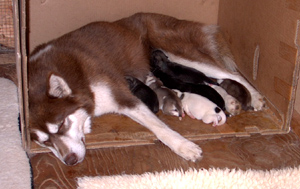
Photo:
Montcombroux
It is imperative not to overfeed the mother for the first four weeks after whelping as she would produce more milk than the pups can take and would develop mammitis (inflammation of the mammary glands). Check her teats every day. They should be soft and pink. The pups show signs of contentment. They make little noises but do not cry. They grow visibly every day. If the teats show swelling, soreness or redness, or if they feel hard, there is inflammation. If this occurs, the pups are unable to suckle and cry loudly for long periods.
If there is an inflammation, reduce the food to just half a normal ration. Give the mother vitamins and plenty of water. Supplement the pups with substitute puppy milk, obtained from a veterinary clinic. If the pups are less than three-weeks-old and mammary inflammation occurs, make the substitute milk into a paste (less water than recommended) dip your finger in it and put it to each pup's mouth and allow them to suck on it. If the pups are three weeks or more, crush the yolk of a hardboiled egg into puppy milk (more paste than liquid) on a large plate. Dip your finger and bring it to a pup's mouth, all the time making an eating sound with your mouth. It will take them no more than a few seconds to start licking the plate. Keep dipping the finger and putting it to the mouth of any pup who does not seem to get the idea.
The inflammation should disappear within 48 hours of reduced food. If not, consult the vet.
PUPPY DEVELOPMENT
(NOTE: Pups born outside develop slower. If they are born in winter, they have trouble putting on weight. The weaker ones may not make it through the winter.)
Up to 3 days old pups sleep when they are not feeding. They twitch and turn and crawl all over each other.
By day 4, they attempt to stand on their legs
At 6 days pups usually can stand.
At 8 days, the pups attempt a step - eyes begin to slit open
At 9 days the eyes are opened.
At 10 days, the pups walk around in the nursery, begin to play with each other.
At 2 weeks pups explore their immediate area and play with one another.
Between 2 and 3 weeks teeth start appearing. They explore more.
Between 3 and 4 weeks, the pups stand on their wobbly legs to take a position to defecate. They cry loudly until the mother licks their anal region. This is normal behavioral development. A week later, they usually can defecate unaided. Some of them still cry, though at that stage the mother tends to ignore them. Pups explore farther, run around, play gets rough, begin to respond to calls, find their way back to the nursery.
Also at three to four weeks, under normal conditions, pups are able to begin consuming a little bit of solid food. This is made of substitute puppy milk usually obtained from the vet. Crush the yolk of a hardboiled egg into puppy milk (more paste than liquid) on a large plate. Leave plenty of this mix available. The mother may wolf it all down at once. Most do not.
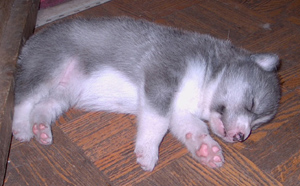
Photo:
Montcombroux
Between 4 and 5 weeks the pups run around, eat solid food, drink water, go outside, respond to calls, find their way back quickly. At this point, pups born indoors should, depending if they are born in winter or summer, start going outside. In winter, outside trips of five to ten minutes tucked into the front of the owner's coat is recommended to assist in acclimatization, this only when the weather is fine. Cold is okay, wet is not. Carry pups outside for a few minutes each day to continue acclimatization. In summer pups can be carried outside and put on the ground but only if it is dry.
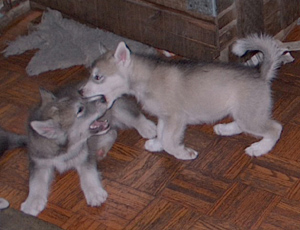
Photo:
Montcombroux
Between 5 and 6 weeks play brings adventurous rough housing and loud squeals. Pups respond to calls, attempt at following, know where food and shelter are. Mother regurgitates food for them.
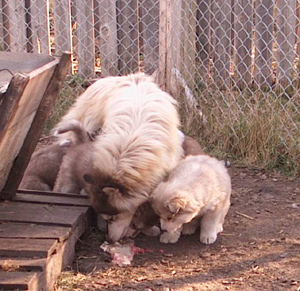
Photo:
Montcombroux
From 6 weeks and on, put the pups outside on the ground or snow for ten minutes or so every day, building up to 10-15 minutes by the end of the week. They will run and explore. They chew on everything. Indoors, the house should be made pup-proof (no cables, cords, shoes, shoe laces, or any object within reach of a curious pup)
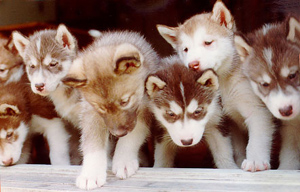
Photo:
Montcombroux
By 7 weeks, leave the pups outside in a pen reserved for them and their mother for an hour or so each day, depending on weather and temperature, building up to 2-3 hours over the week.
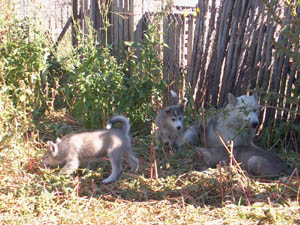
Photo:
Montcombroux
At 8 weeks, pups are strong and running well. They can stay during day in the pen as long as the weather is dry and they have a good house with plenty of straw. They should come in at night for the first three days, after which they should be acclimatized enough to stay the night. They can go on short walks.
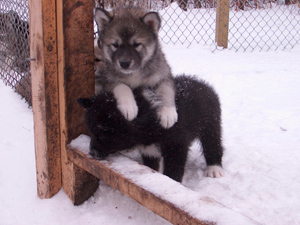
Photo:
Montcombroux
From 9 weeks on, lots of interaction between owner and pups. Let them view the other dogs, but not close enough that they could be bitten.
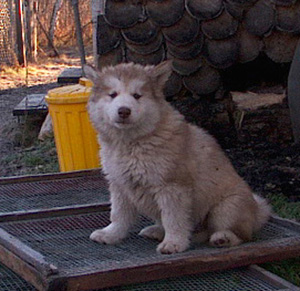
Photo:
Montcombroux
When the pups are 3 months old, it is time for their introduction to the other dogs. One person walks the mother while in harness, the other walks another adult dog on a leash, watching the older dog closely. Also watch the mother - she is still highly protective. Male dogs want to nip the pups. After the pup squeals, the adult dog accepts it. After years of observation, I concluded that in this manner the adult dog recognizes the pup as a pack member and not as prey. The adult dog will want to smell each pup to identify the family. Pups squeal and submit.
It may take several walks over several days to introduce all the adult dogs as the pups can only go for one walk at a time.
By this stage the mother will no longer regurgitate for her pups. They will eat as much as an adult dog.
At 4 months- and not before - if there has been no trouble at all with the dogs and the pups, then introduce mother and pups into the general pen for a couple of hours at a time, while you can supervise.
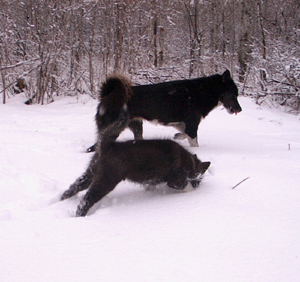
Photo:
Montcombroux
At 5 months, if there has been no trouble, pups can live in the general pen providing they have their own houses, i.e. a double size house for mother (a pup or two will often go and sleep with her) and one double size house for every two pups. The most successful shelter I have is a 4' x 8' x 3' high house with a 4' x 8' covered porch. Later I added a couple of smaller houses. Pups, like all Inuit Sled Dogs, do not like sleeping on their own.
Also by 5 months pups are fed in individual bowls. They rush on the food. When the bowls are empty, except for a few scraps, they will change bowls. Sometimes a pup will refuse to let go of his bowl when he his shouldered by a sibling. A minor growl is heard. The pushy pup will then put his head over the neck of the reluctant pup and growl loudly. The first pup will growl in response. Half the time, a short fight erupts. The adults may have finished eating, but they do not interfere.
At 6 months, if it is summertime, you can start training the pups by having them running in harness while you ride a bike. Since pups have a tendency to dash sideways off the trail, you may want to start by walking them in harness.
By 7 or 8 months the pups change feeding bowls in a well-orchestrated dance, which most of the time includes the adults. The pack mentality and its rules are in full force.